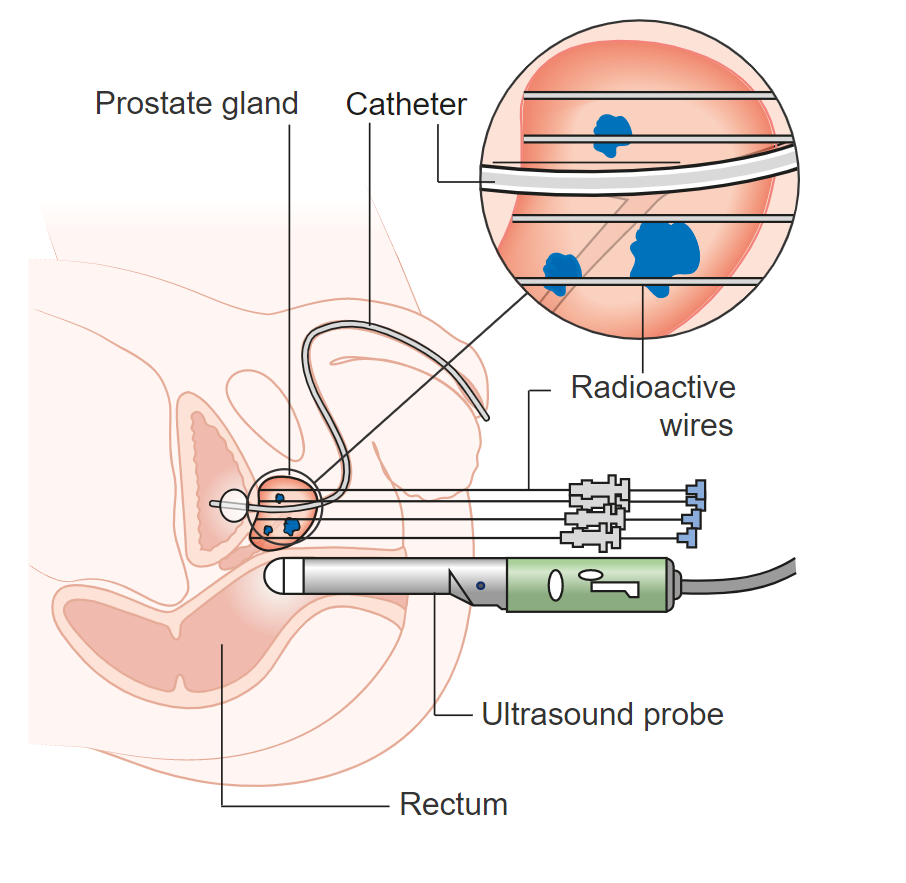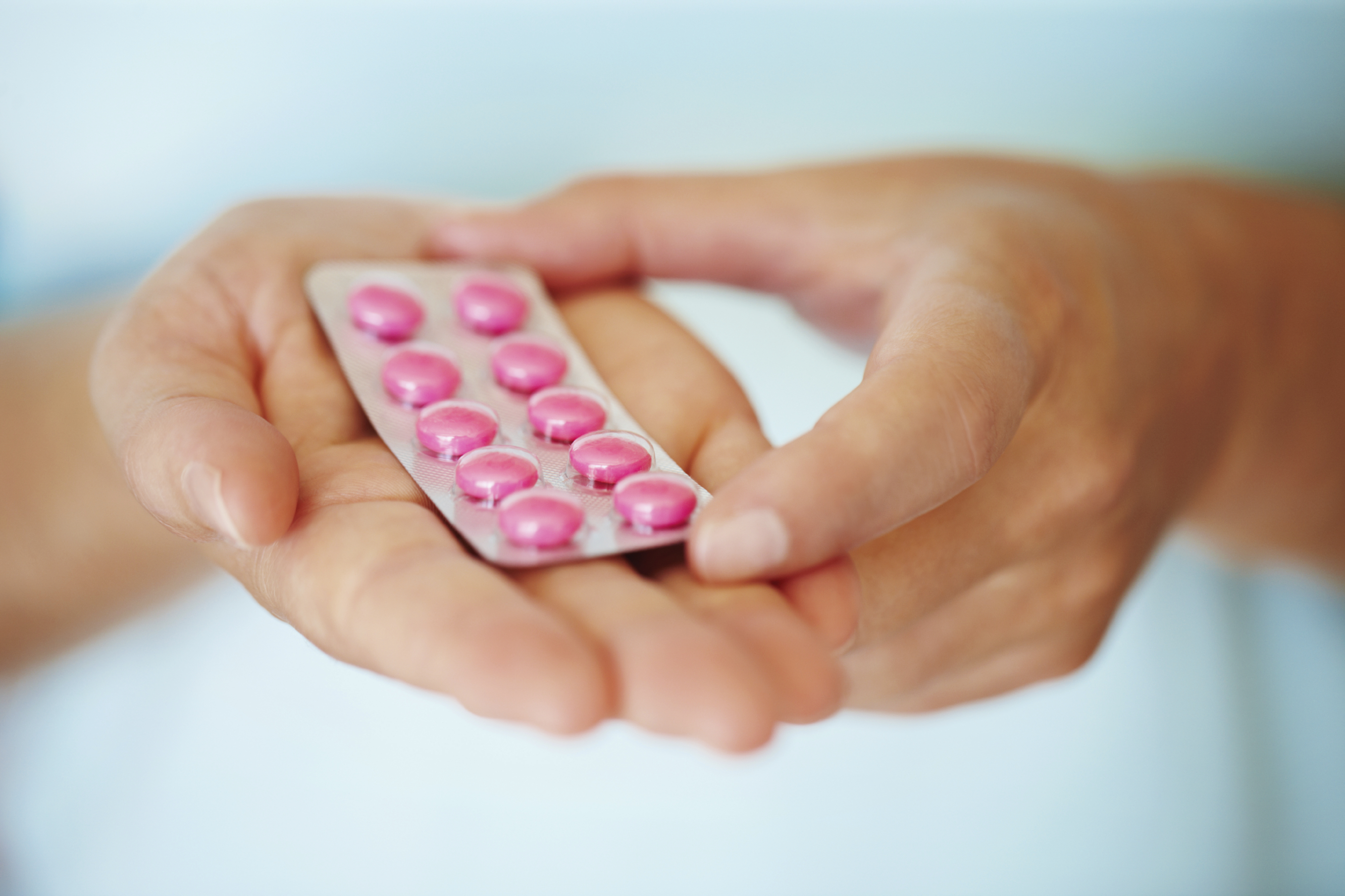Brachytherapy for prostate cancer

On this page:
Brachytherapy is a type of radiotherapy. The radioactive source is put inside your prostate.
There are 2 types of brachytherapy:
Low dose rate (LDR)
Tiny radioactive seeds are put into your prostate. They stay there permanently and slowly release radiation.
High dose rate (HDR)
A radioactive source is placed into your prostate for a few hours and then removed, to deliver a high dose of radiation.
Who can have brachytherapy?
Your doctor will let you know if you are suitable for brachytherapy.
You may not be suitable if you have trouble passing urine, have a very large prostate gland or have recently had surgery to your prostate gland.
- If you have a larger prostate gland - you may be given hormone therapy to shrink it before brachytherapy.
- If you have higher-risk prostate cancer - you may receive brachytherapy along with another treatment. For example, you may need some doses of external beam radiotherapy or hormone therapy as well.
LDR brachytherapy
With LDR brachytherapy, tiny radioactive seeds are put into your prostate. The seeds release radiation slowly over a number of months. The radiation destroys prostate cancer cells. The seeds stay in your prostate. The radiation stays active for about 10-12 months.
Before LDR brachytherapy
A few weeks before you will have a trans-rectal ultrasound scan of your prostate.
The scan pictures will show the exact size and shape of your prostate so the doctor knows how many seeds need to be used and where they should be placed.
The day before the seeds are put in (implanted), you may be asked to follow a special diet and take medication to clear your bowels. The nurse will let you know what you need to do.
Putting in the brachytherapy seeds
You will be taken to an operating theatre to have the seeds put in under a general anaesthetic. This means you will be asleep during the procedure. Occasionally, a spinal anaesthetic will be used. This means you will be awake during the procedure but will not feel anything.
An ultrasound probe is first put in your back passage to show up your prostate. Then about 60 to 80 radioactive seeds are put into your prostate through the skin between your scrotum and anus using a fine needle. The seeds are about the size of a grain of rice. It takes about 90 minutes to put in all the seeds.
After LDR brachytherapy
- A tube (catheter) will be put into your bladder during the operation. The tube will drain any urine. It may be left in for a couple of hours or overnight.
- Mild soreness and some bruising between your legs can happen after the seeds have been put in. Your doctor can prescribe mild painkillers to relieve this.
- Blood can appear in your urine afterwards, but most bleeding usually goes within 48 hours. If it goes on beyond that, let your doctor know.
- You may be given antibiotics to prevent an infection. You should take the full course as instructed.
- You may be given alpha blockers. Alpha blockers are tablets to help relax your bladder and make it easier to pass urine.
Usually you will be able to go home the same day once you have recovered from the anaesthetic and can pass urine normally.
You will have a follow-up appointment about a month after getting the seeds.
At some stage after treatment you will have another scan. This is to check the position of the seeds. A small number of people may need to have a few extra seeds added.
Hints and tips
- Do not drive for 24 hours after having a general anaesthetic.
- Take it easy and avoid heavy lifting and straining for 2 or 3 days.
- It is safe to bathe or shower any time after the seeds are put in.
- Return gradually to your regular diet.
- Avoid cycling for a number of weeks and then start again gradually.
- Avoid foods that may irritate your bowel and avoid getting constipated.
- There’s a slight chance that a seed could be passed out in your semen or urine, although this is rare. If you do pass a seed, tell the radiotherapy unit. Don’t handle the seed with your fingers and flush it down the toilet.
- Carry a medical alert card with you, if you’re given one. This tells medical professionals and airline security staff that you have radioactive implants.
Is the radiation safe?
The radiation is released into your prostate gland over the first few months. After about 12 months, the seeds are no longer active. The seeds can stay in your prostate without doing any harm.
- It is safe for you to be around other people and pets during this time.
- As a precaution it is best to avoid close physical contact (less than an arm’s length) with small children or pregnant women for the first 2 months after treatment.
- Follow the advice from the hospital about any specific precautions you need to take.
HDR brachytherapy
HDR brachytherapy uses a high dose of radiation. Instead of using permanent seeds, radioactive sources are put into the prostate on the ends of wires, using needles. Then the needles and radiation sources are removed after about 3 hours.
Before HDR brachytherapy
The day before treatment you may be asked to follow a special diet and take medication to clear your bowels. The nurse will tell you what to do.
How is HDR brachytherapy given?
You may have a general anaesthetic (which means you will be asleep during the procedure) or a spinal anaethestic (which means you will be awake but won't feel anything). The needles are passed into your prostate and surrounding tissue through the area between your scrotum and anus. This may take about an hour.
You may stay under anaesthetic and have the radioactive sources put into the needles, or you may be woken up and have treatment later than day under spinal anaesthetic.
In the treatment room, the needles in your prostate will be attached to the HDR machine. This machine feeds the radioactive sources (wires) through the needle and into the prostate. The needles are left in for about 3 hours and then removed.
After HDR brachytherapy
- You will not be able to drive for 24 hours after the anaesthetic.
- You may be given antibiotics to prevent an infection. You should take the full course as instructed.
- You may be given alpha blockers. Alpha blockers are tablets to help relax your bladder and make it easier to pass urine.
- If you are also having external radiotherapy, you may have a planning scan about 2 weeks after your procedure.
- You will not be radioactive after HDR radiotherapy.
Side effects of brachytherapy
Which side-effects you may get and how severe they are varies from person to person. Tell your medical team if you are troubled by any side-effects.
Bruising, pain, swelling
You may have bruising, pain or swelling in the area between your scrotum and anus. It should only last a few days and you may take paracetamol of you need it.
Urinary problems
You may have some blood in your urine but this normally goes within the first few days. Tell your doctor if it continues.
The radiation can irritate and inflame the tube through which you pass urine (pee). This can cause symptoms such as burning sensation when you pee, needing to pee more often, having a slow stream, finding it harder to start to pee and needing to go more quickly than you used to.
If you cannot pass urine afterwards, this is called urinary retention. It doesn't happen very often, but if it does, you will need to have a tube (catheter) put in for a short period of time.
If you have urinary problems before brachytherapy, you're more at risk of problems passing urine afterwards. Leaking urine is rare, but if you've had prostate surgery before brachytherapy the risk of leaking urine is higher.
Read more about managing urinary problems.
Erection problems (erectile dysfunction)
Brachytherapy can damage the nerves and blood vessels near your prostate gland. This might have an effect on your erections. This is called erectile dysfunction (ED) or impotence. You may not notice changes until years after your treatment. It may also become a long term or permanent problem.
Your risk of erectile problems increases if you had problems before your treatment or if you have hormone therapy together with your brachytherapy.
You might find this side-effect very hard to deal with if it happens to you. There are things that can help, so talk to your doctor or nurse if you have any problems. They are used to talking about erectile difficulties, so try not to be embarrassed. You can read more about sexual side-effects and treatments for ED.
Infertility
Brachytherapy may affect your fertility. This means you may not be able to father a child in the future. If this is important to you, talk to your doctor about this before treatment starts. You should still use contraception to prevent pregnancy unless you have been told that you are no longer fertile. Read more about infertility.
Bowel problems
Your bowel may become inflamed after brachytherapy. This may cause some bleeding or a change in your bowel habit, such as needing to go to the toilet more often. Avoid any foods that irritate your bowel and avoid getting constipated.
Bowel problems may happen straight away or up to 2 to 3 years after treatment. If this happens, talk to your doctor. There may be treatments that can help.
Fistula
A fistula is a tear between your bladder and bowel. It is a very rare side-effect. If you get a fistula you will need to wear a bag to collect your bowel movements (poo) and urine (pee).
Fatigue
Fatigue is when you feel very tired. It usually takes a few months for fatigue to improve. Read more about coping with fatigue.
Sex after brachytherapy
- Talk to your doctor or nurse about when you can start having sex again after brachytherapy.
- You should wait at least 2 weeks after treatment before having sex. It may be a while before you feel like having sex if you’re sore or tired.
- It is safe for you and your partner to sleep in the same bed (if your partner is not pregnant).
- There is a small risk that a seed may come out in your semen when you are having sex. You should use a condom to catch the semen the first 4-5 times you have sex.
- Don’t worry if your semen is black or brown in colour. This is normal and due to bleeding when the seeds are put in.
Advantages and disadvantages of brachytherapy
Advantages
- Treatment time is short: 1-2 days.
- You can return to your normal routine quite quickly.
- Compared to external radiotherapy, brachytherapy may have fewer immediate side-effects and cause less damage to surrounding tissues like the back passage, urethra and bladder.
Disadvantages
- It can cause urinary, erection and bowel problems.
- You may have some temporary discomfort after the procedure.
- You will need to have a general anaesthetic.
- You may not be able to have prostate surgery in the future, due to the effects of the radiotherapy.
For more information
Phone
1800 200 700



